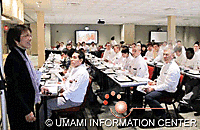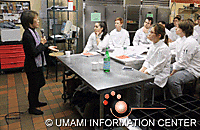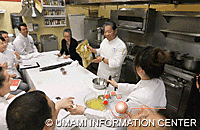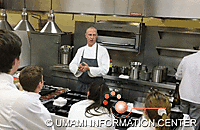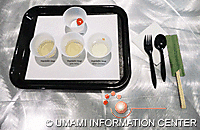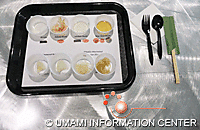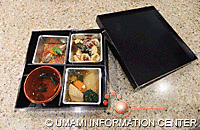[Activity Report] The Culinary Institute of America Hyde Park Umami Lecture
April 2014
In December of last year, "Washoku, traditional dietary cultures of the Japanese" was designated as an intangible cultural heritage by UNESCO. Umami, which is an important factor in Japanese cuisine, has now become a common international word "UMAMI". It not only attracts interests of famous chefs throughout the world but also is starting to make overseas culinary schools realize the necessity of umami education. In response to such a trend, the Umami Information Center held an umami lecture at The Culinary Institute of America Hyde Park, which is a U.S. culinary college that is renowned for the world's top level professional culinary culture and technique education, as we did last year.
The lecturers included Mr. Yoshihiro Murata, who is the third generation owner of "Kikunoi" in Kyoto who as the chairman of Japanese Culinary Academy made great efforts in the designation (of "Washoku, traditional dietary cultures of the Japanese" as an intangible cultural heritage), Mr. Kyle Connaughton, who is a former executive chef of the Fat Duck in London and Kumiko Ninomiya Ph.D. of Umami Information Center.
Dr. Kumiko Ninomiya (also known as umami mamma) introduced the key basic information of umami, such as umami compounds, ingredients that are rich in umami, and characteristics and functions of umami, etc., from a scientific perspective so that it would enhance the understanding of the following lectures and demonstrations. Furthermore, she gave an umami tasting experience, which is introduced under "Tasting Umami" on our website, using cherry tomatoes and vegetable soup. Participants tasted umami, which is a subtle taste that spreads throughout the tongue, and deepened their understanding.
Mr. Yoshihiro Murata gave a lecture and demonstration on "dashi and umami in Japanese cuisine". He explained the fact that Japanese cuisine, which is structured with umami at its center, is low fat and low calorie, unlike Western cuisine. He also explained the synergistic effect of umami with glutamate from kombu and inosinate from katsuobushi (dried bonito flaks), which are umami compounds. He introduced that they can make New Style Dashi even without kombu and katsuobushi by using ingredients like dried tomatoes, dried morel, and minced chicken breast with less fat, etc., as long as they understand the principle of the synergistic effect. Participants understood the characteristics of 'dashi', which is the key to Japanese cuisine, through sampling of kombu dashi, katsuobushi, ichiban dashi (flavored dashi), and New Style Dashi and learned that they can make 'dashi' with ingredients that are readily available.
In the lecture on the 'history of umami in the U.S.', Mr. Connaughton introduced that the recognition of umami being the 5th basic taste was promoted by the discovery of umami receptor on our tongue in the beginning of 2000, that chefs in the U.S. added umami to their dishes by using Japanese ingredients at the time, and that famous chefs now create unique umami ingredients by making miso from chickpeas and making dried pork instead of katsuobushi by using pork, etc. In the demonstration, he also used dried tomatoes, dried morel, and minced chicken breast in the same manner as Mr. Murata and introduced a pasta dish using umami broth, which is a clear 'dashi' that was made in a different cooking method than New Style Dashi, as well as sauteed sardine served with umami sauce, in which umami had been concentrated by cooking tomatoes down for a long time. Mr. Connaughton communicated to the students the fact that learning umami's basic knowledge enables them to create original umami recipes without using special Japanese ingredients and that umami is a universal taste through the lecture and the demonstration.
Finally, the Umami Tasting Bento Box containing Mr. Murata's clear soup osuimono using New Style Dashi and Vegetable takiawase (vegetables cooked separately but served together) and Mr. Connaughton's pasta dish with umami broth as the sauce and sardine served with umami sauce was handed out to everyone. Participants experienced the importance of umami in cooking and how to use umami ingredients while carefully tasting umami dishes.
In the afternoon lecture, they gave the same lectures and demonstrations as the morning lecture in the Asian Cuisine Class Room (cooking demonstration room). The distance between students and lecturers was close, due to the small number of participants, and the class was packed with great learning opportunities for 3 hours. We are grateful that we were able to successfully host the lecture, thanks to Mr. Yoshihiro Murata and Mr. Kyle Connaughton who gave us cooperation as lecturers.
The Umami Information Center will continue to promote these umami lecture activities to enable domestic and overseas culinary school students to gain correct understanding of umami. We thank you in advance for your continuous support in the future.
